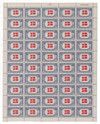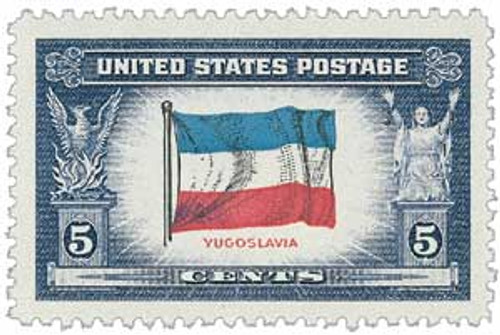
# 920 - 1943 Overrun Countries: 5c Flag of Denmark
5¢ Flag of Denmark
Overrun Countries Series
City: Washington, D.C.
Quantity: 14,999,646
Printed by: American Bank Note Company
Printing Method: Flat-Plate
Perforations: 12
Color: Blue violet, red, and black
Harlem Renaissance novelist Nellallitea “Nella” Walker Larsen was born on April 13, 1891, in Chicago, Illinois. Though her writing career was brief, Larsen produced some of the first groundbreaking works to focus on mixed race identity and the feeling of not belonging. Larsen’s mother was a Danish immigrant and her father a multiracial Afro-Caribbean immigrant from the Danish West Indies. Her father died when she was young, and her mother remarried another Danish immigrant and had another child with him. The family briefly moved to a largely white neighborhood, but faced discrimination because of Nella. Throughout childhood, Larsen had little exposure to African American culture. As author Darryl Pinckney wrote, “as a member of a white immigrant family, she had no entrée into the world of the blues or of the black church. If she could never be white like her mother and sister, neither could she ever be black in quite the same way that Langston Hughes and his characters were black. Hers was a netherworld, unrecognizable historically and too painful to dredge up.” Larsen and her family spent time in Denmark between 1895 and 1898. She enjoyed her time there, learning Danish children’s games, which she later wrote about fondly. When she was old enough, Larsen’s mother encouraged her to enroll at Fisk University, a traditionally African American school in Nashville. Larsen’s mixed race stood out among the other students. Most were from the South and descended from former slaves. Larsen was asked to leave the university in 1908 after only one year. Larsen returned to Denmark on her own for three years, then moved to New York City to study nursing. After graduating in 1915, she went to the Tuskegee Institute in Alabama, where she was made head nurse. Unhappy with the working conditions there, she left after a year and returned to New York. In 1916, she got the second-highest score on the civil service exam and worked as a nurse for the city’s Bureau of Public Health. She worked in that capacity during the 1918 flu pandemic. Larsen married physicist Elmer Imes in 1919 and the couple moved to Harlem in the 1920s. Even here, she was a bit of an outsider. While other members of the community were of mixed race, they had grown up poor and didn’t graduate from college. In 1921, Larsen began working the New York Public Library and became the first black woman to graduate from their school. Larsen helped to integrate some of the city’s libraries. In 1925, she began writing her first novel and quit the library in 1926 to dedicate her time to writing, as part of the Harlem Renaissance. Published in 1928, Larsen’s Quicksand was a largely autobiographical work based on her experiences as a mixed-race woman. Throughout her life, she was made to feel like an outsider for this, as well as for her low-income origins and lack of a college degree. The novel was praised by critics and encouraged Larsen to continue writing.Birth of Nella Larsen
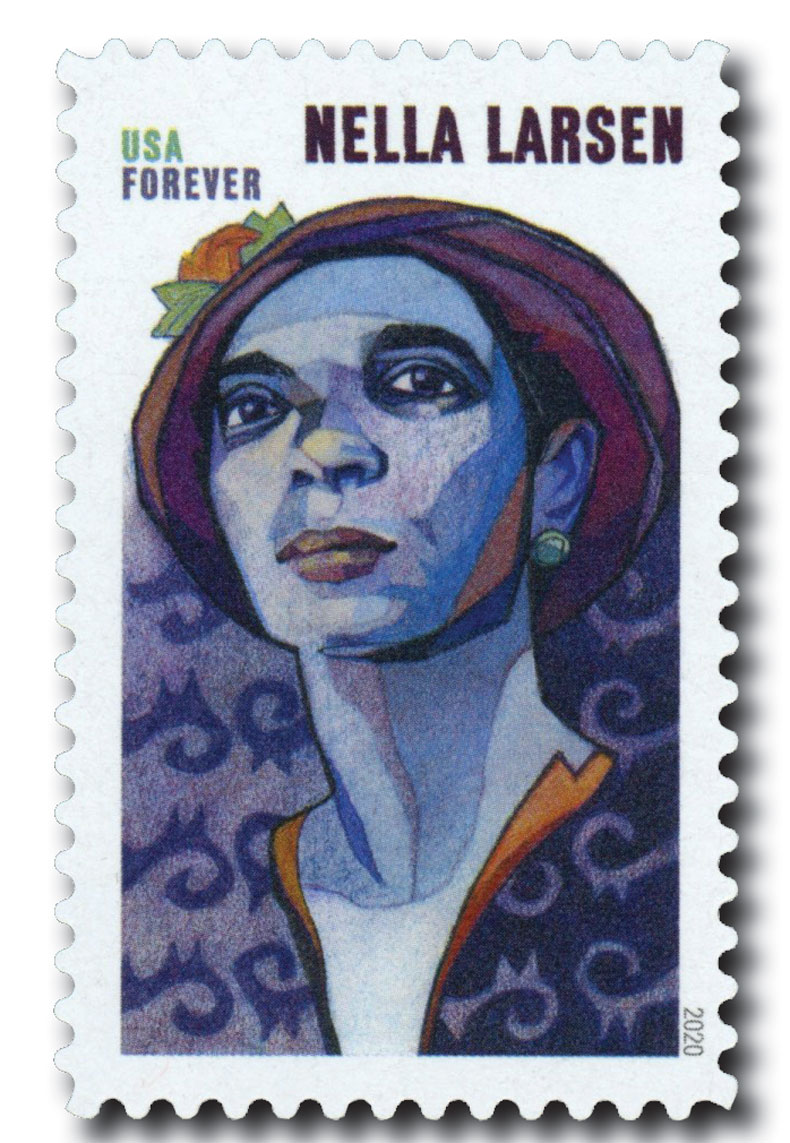
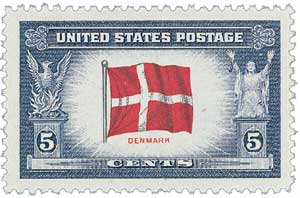
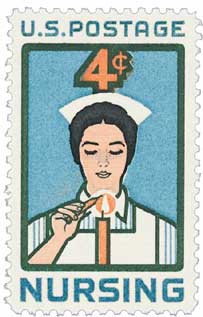
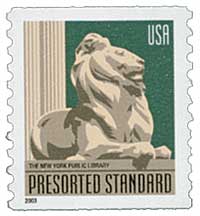
Larsen published her second novel, Passing, in 1929. It told the story of two mixed-race African American women who followed different paths in life. She then published the short story “Sanctuary” in 1930 and was then the first African American woman to earn the Guggenheim Fellowship. She spent several years in Europe before returning to New York in 1937. She soon stopped writing and returned to nursing. She died in New York on March 30, 1964.
5¢ Flag of Denmark
Overrun Countries Series
City: Washington, D.C.
Quantity: 14,999,646
Printed by: American Bank Note Company
Printing Method: Flat-Plate
Perforations: 12
Color: Blue violet, red, and black
Harlem Renaissance novelist Nellallitea “Nella” Walker Larsen was born on April 13, 1891, in Chicago, Illinois. Though her writing career was brief, Larsen produced some of the first groundbreaking works to focus on mixed race identity and the feeling of not belonging. Larsen’s mother was a Danish immigrant and her father a multiracial Afro-Caribbean immigrant from the Danish West Indies. Her father died when she was young, and her mother remarried another Danish immigrant and had another child with him. The family briefly moved to a largely white neighborhood, but faced discrimination because of Nella. Throughout childhood, Larsen had little exposure to African American culture. As author Darryl Pinckney wrote, “as a member of a white immigrant family, she had no entrée into the world of the blues or of the black church. If she could never be white like her mother and sister, neither could she ever be black in quite the same way that Langston Hughes and his characters were black. Hers was a netherworld, unrecognizable historically and too painful to dredge up.” Larsen and her family spent time in Denmark between 1895 and 1898. She enjoyed her time there, learning Danish children’s games, which she later wrote about fondly. When she was old enough, Larsen’s mother encouraged her to enroll at Fisk University, a traditionally African American school in Nashville. Larsen’s mixed race stood out among the other students. Most were from the South and descended from former slaves. Larsen was asked to leave the university in 1908 after only one year. Larsen returned to Denmark on her own for three years, then moved to New York City to study nursing. After graduating in 1915, she went to the Tuskegee Institute in Alabama, where she was made head nurse. Unhappy with the working conditions there, she left after a year and returned to New York. In 1916, she got the second-highest score on the civil service exam and worked as a nurse for the city’s Bureau of Public Health. She worked in that capacity during the 1918 flu pandemic. Larsen married physicist Elmer Imes in 1919 and the couple moved to Harlem in the 1920s. Even here, she was a bit of an outsider. While other members of the community were of mixed race, they had grown up poor and didn’t graduate from college. In 1921, Larsen began working the New York Public Library and became the first black woman to graduate from their school. Larsen helped to integrate some of the city’s libraries. In 1925, she began writing her first novel and quit the library in 1926 to dedicate her time to writing, as part of the Harlem Renaissance. Published in 1928, Larsen’s Quicksand was a largely autobiographical work based on her experiences as a mixed-race woman. Throughout her life, she was made to feel like an outsider for this, as well as for her low-income origins and lack of a college degree. The novel was praised by critics and encouraged Larsen to continue writing.Birth of Nella Larsen




Larsen published her second novel, Passing, in 1929. It told the story of two mixed-race African American women who followed different paths in life. She then published the short story “Sanctuary” in 1930 and was then the first African American woman to earn the Guggenheim Fellowship. She spent several years in Europe before returning to New York in 1937. She soon stopped writing and returned to nursing. She died in New York on March 30, 1964.







